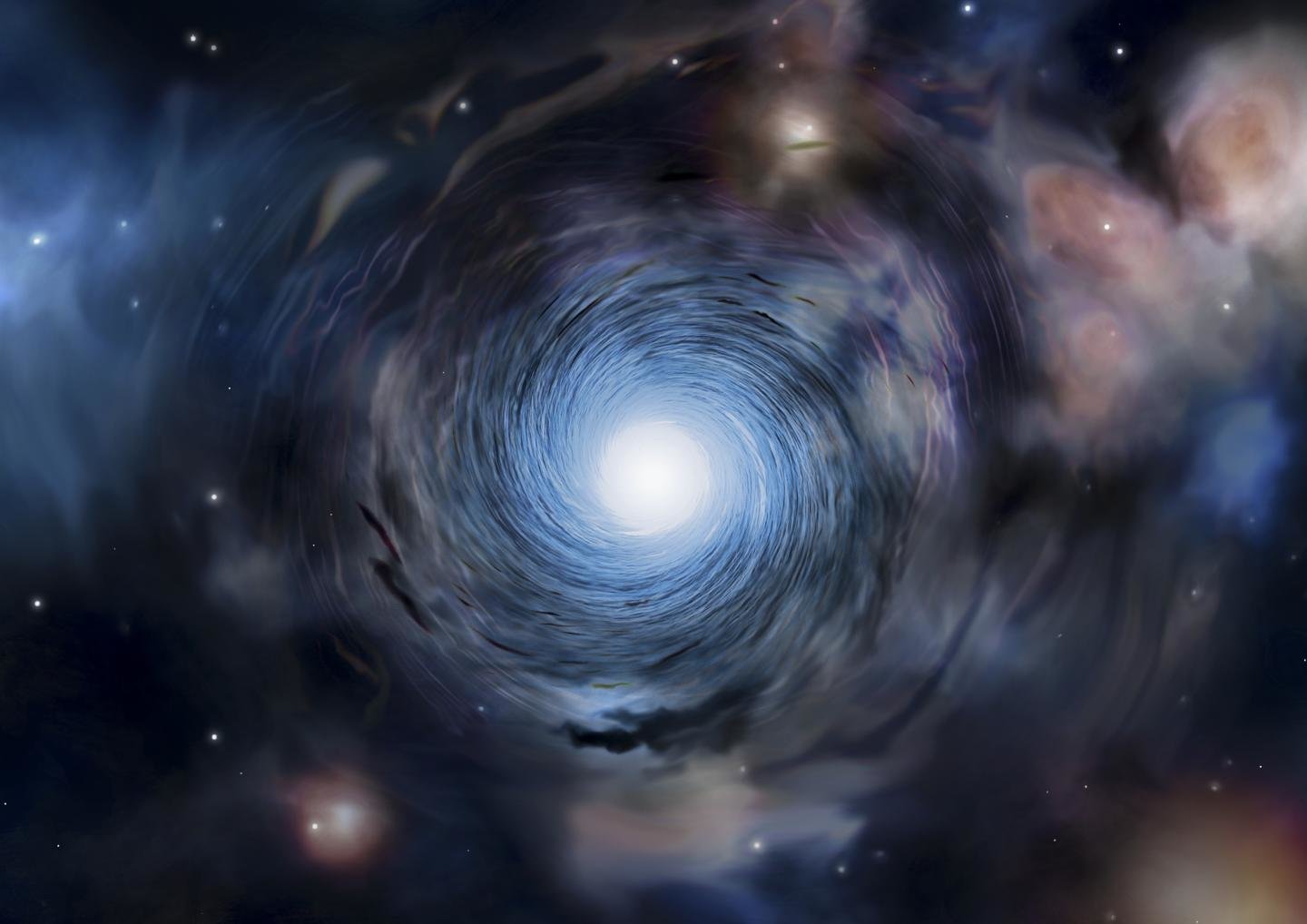The Youngest Galaxies in the Universe Spin Like the Mature Milky Way

Astronomers have looked back nearly 13 billion years and found very early galaxies that exhibit a steady swirling motion, very similar to the spin of galaxies that exist today. This type of motion was not expected to occur in young, turbulent galaxies of the early universe.
"We have seen the motion of gas in very early galaxies for the first time," said Dr. Renske Smit from the Kavli Institute of Cosmology at the University of Cambridge, speaking today at a briefing at the American Astronomical Society meeting held this week in Washington D.C. "And while we have identified only two such galaxies, we know that at least some early galaxies must have evolved very rapidly to reach this early maturity."
Smit said these first observations of the movement of gas provides unique details about the formation of these galaxies and opens a window to the early universe.
Smit and her colleagues used the Atacama Large Millimeter/submillimeter Array(ALMA) in Chile to observe two small newborn galaxies in far-infrared wavelengths, seeing them as they existed 12.9 billion years ago, just 800 million years after the Big Bang.
The astronomers peered very deep into the universe to look for light from galaxies that is red-shifted to confirm that these galaxies are very far away.
"Looking back in time, we know that in the early universe — the first few hundred million years of cosmic time — the first stars and first galaxies emerged," Smit explained. "The radiation of these galaxies gradually ionized the neutral hydrogen that pervaded the early universe, and we call this the epoch of re-ionizaton."
A spectral characteristic of ancient and distant galaxies is strong hydrogen-emission lines, known as Lyman-alpha lines, which appear in a spectrum if the source emits specific wavelengths of radiation.
Get the Space.com Newsletter
Breaking space news, the latest updates on rocket launches, skywatching events and more!
But one problem in observing galaxies from this epoch is that the obscuring cloud of neutral hydrogen gas scatters such Lyman-alpha photons and makes it difficult to see, especially with optical telescopes. Smits said one way to get around this is to look at a different wavelength range: Millimeter wavelength observations can peer through the “haze.”
They identified two candidate galaxies using imaging from the Hubble and Spitzer space telescopes, where the data showed these galaxies appeared to have unusually high rates of star formation.
Using ALMA to observe the two galaxies, the astronomers saw small frequency shifts.
"This showed us there is movement in the gas, where on one side, the gas is moving toward us and other side, the gas is moving away," Smits said. "That provides the impression of rotation, which is very similar to what we see in current galaxies and what we see in our own Milky Way. We did not expect to see the same things in the early universe as what we see now."
Smits said the early universe was very turbulent, with a lot of gas rapidly streaming into galaxies. Additionally, there were frequent supernovae that could expel gas from galaxies.
"These effects lead us to believe that early galaxies would be very turbulent and very chaotic in their motions, so it was a surprise to see regular, rotating motion in these two galaxies because a rotating galaxy indicates maturity," Smits said. "When the chaotic motion is not dominating, it says that the galaxies are very mature. It leads us to conclude that at least some galaxies must evolve very rapidly to reach this early maturity."
RELATED: This Is the Deepest View Into the Universe That Has Ever Been Seen
Smits told Seeker that these two galaxies look very similar to galaxies from about 3 billion years after the Big Bang, which was the peak of star formation in the universe. They are about five times smaller than the Milky Way, but they were forming stars at a higher rate than other young galaxies during that time period.
The researchers also gained insight on the shape of the galaxies — whether they are spiral or elliptical.
"Usually spiral patterns need more time before they develop," Smits told Seeker. "There is some turbulence we observed, and these are smaller galaxies. So they are a little bit like the Milky Way but more turbulent."
Smits said they need to conduct more observations to determine if these galaxies are truly quite different from others galaxies in that time period or if they represent a larger population of evolved galaxies.
"With our observations and what we see with Hubble, it all points to these galaxies being slight outliers," Smits said. "These galaxies must somehow be more evolved than other galaxies, and we'd like to know why."
Originally published on Seeker.
Join our Space Forums to keep talking space on the latest missions, night sky and more! And if you have a news tip, correction or comment, let us know at: community@space.com.

Nancy Atkinson is a science journalist and author who works to tell the stories of people involved in space exploration and astronomy. She has written two books about the people behind NASA projects like the Apollo missions and the robotic rovers exploring our solar system, and hosted/worked on several astronomy podcasts. A writer for Universe Today since 2004, Atkinson's work can also be found at The Planetary Society and Ad Astra, the magazine of the National Space Society. Other work can be found at Seeker, New Scientist, Wired.com, Space.com, NASA’s Astrobiology Magazine, Space Times Magazine, and several newspapers in the Midwest.









